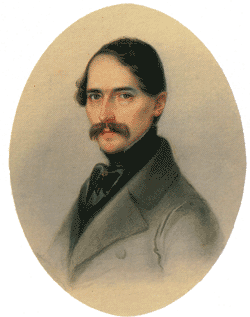
Council of Heads of Australasian Herbaria
Australian National Herbarium
Biographical Notes
 |
Council of Heads of Australasian Herbaria |
 Becker,
Ludwig Philipp Heinrich (1808-1861)
Becker,
Ludwig Philipp Heinrich (1808-1861)Born Offenbach-on-Main near Darmstadt, Germany, 5 Sept. 1808; died Bulloo, S of Cooper Ck, Qld, 28 Apr. 1861 [dysentery, scurvy]
He was the eldest of five children. His father, Ernst Friedrich Becker, held what was considered a respectable civil service position as a lotto director, and in 1821 became auditor for the Archduke of Hesse-Darmstadt. His mother, Amona Eleanora Becker, née Weber, also of Rodelheim, died at Darmstadt when Ludwig was only eleven years old. The following year his father married Johanette Christiane Weber of Rodelheim, perhaps his sister-in-law.
Ludwig was attended the Ludwig Georg Gymnasium [school] in Darmstadt where he studied the classics, natural sciences and art, and it was here that he began a lifelong association with Johann Jakob Kaup, five years his senior, who was to become one of the foremost zoologists of Europe. By 1929 he had moved to Franfurt-am-Main where he worked as a painter for the printing, publishing and bookbinding firm of Heinrich Ludwig Bronner. He also undertook private portrait painting commissions. Much of his movements at that time are uncertain. In 1848 it is probable, though not certain, that he supported the liberal ideals of that year's revolutions againt the autocratic regimes with prevailed in Germany. By 1850 he was in England, involved in science, and presenting papers at meetings.
He sailed in the Hannah, a 480 tons master, from Liverpool on 4 November 1850. There the ship had attracted much attention being, he wrote to Kaup, "the finest in dock, a 3-master, 520 [sic] tons 6 months old, American structure, fast sailor". It had been chartered by a Mr W. A. Gardiner of Manchester who was accompanied by his wife and family, and was bringing out at his own expense twelve young women "as a donation to the colony". The ship also carried a cargo of wine, spirits, seven pianos and agricultural implements, and fourteen dogs of several breeds. Becker speculated on the interesting result of the possible union of the greyhound and the poodle, the collie and the pug. The ship stopped at Pernambuco for a few weeks during the voyage. This enabled Becker to visit Rio de Janeiro, and later gave rise to reports that he had lived there for a while and had thought of staying in South America.
He arrived Launceston, Tas., 10 Mar.1851; and then in Nov. 1852 headed to the Bendigo goldfields, Vic. where he found enough gold to repay his debts to his old friend Kaup. He then returned to Melbourne where he was involved with the arts scene. Where he was recognised as a scientist, artist, botanical illustrator, and lithographer. Here he illustrated works for Ferdinand Mueller including some in early parts of F.Mueller, Fragmenta Phytographiae Australie (1858-1882) and The Plants Indigenous to the Colony of Victoria (1860-1865). During his years in Melbourne he had lodged in the Union Hotel, and in his eccentric way kept a bat for company.
He was 52 when he applied to the Eploration Expedition Committee to join the ill-fated Burke & Wills expedition to cross Australia from south to north. Becker kept his diary as faithfully as he could and sent five full reports, and a number of letters, some 70 sketches and meticulous meteorological observations back to Melbourne.
This disastrous expedition is well documented. The Royal Commission that followed the death of Burke & Wills determined that:
"Dr. Becker died of dysentery and the exhaustion consequent upon it; of course with some peculiar symptoms, which were principally owing to the affection of scurvy."
References: M.Tipping Ludwig Becker (1979); J.Kerr The Dictionary of Australian Artists (1992); T.Darragh Ludwig Becker, a Scientific Dilettante Hist Rec Aust Sci. 11(4)(1997); E.Kynaston A Man on Edge (1981); H.Hewson Australia - 300 Years of Botanical Illustration (1999)
Artist, explorer, naturalist. Arrived Launceston, Tas., 10 Mar.1851; then in Nov. 1852 to Bendigo goldfields, Vic.
At exhibition in Melbourne in 1854 showed specimens of algae & fish 'designed to furnish new designs for paper hangings'. Member of council for Philosophical Institute of Vic. 1857.
Did botanical drawings for Mueller (pub. in Fragmenta, Pis Indig. Col.Vic, Pis Indig. Vic), & William Hooker.
Artist & naturalist to Victoria Exploring Expedition (Burke & Wills) q.v., 1860-61, sending back specimens, drawings & notebooks from Menindie.
Commemorated in Disoon, Eremophila, Hovea, Ptilotus.
Source: George, A.S. (2009) Australian Botanist's Companion, Four Gables Press, WA. [consult for source references]